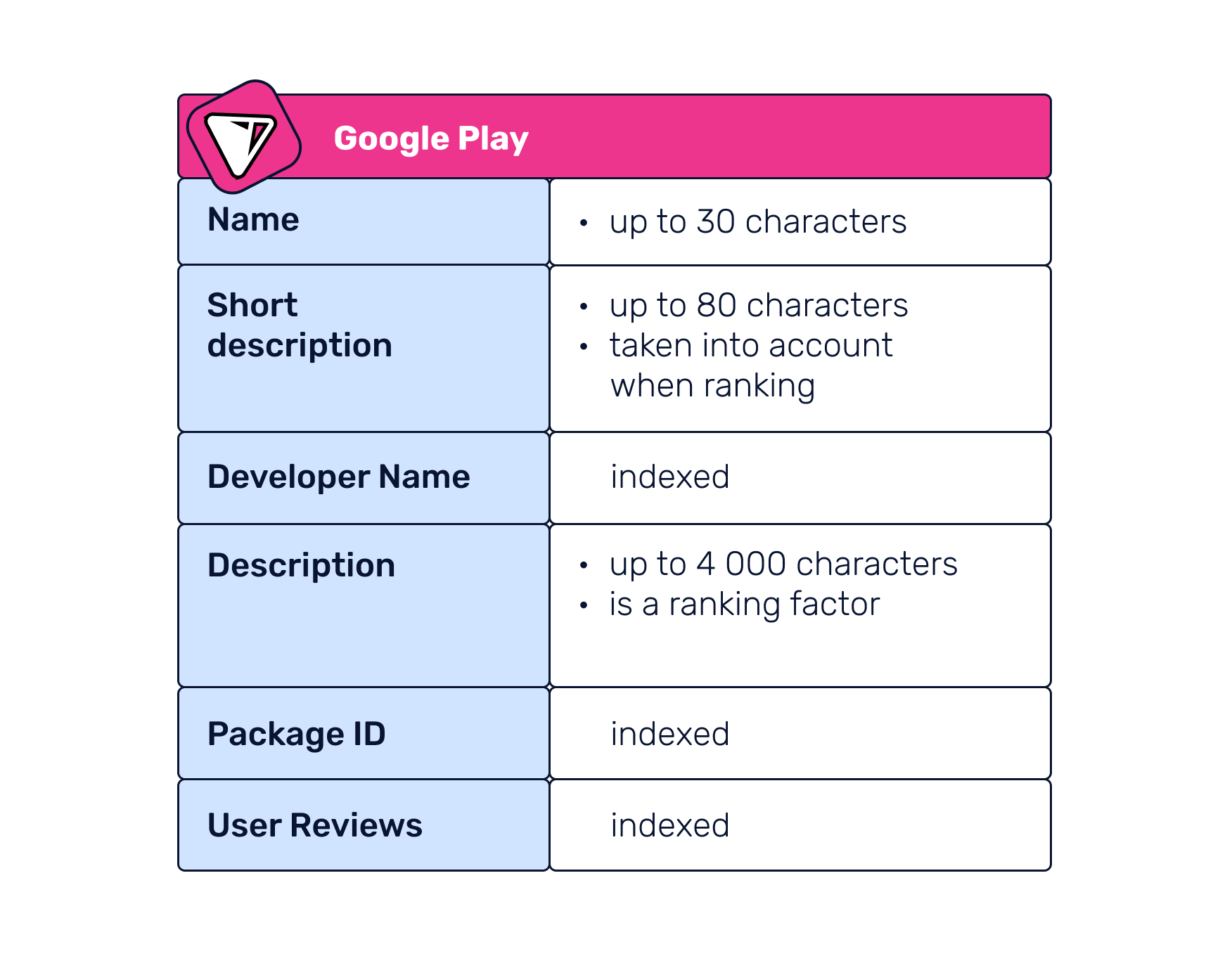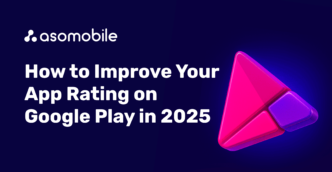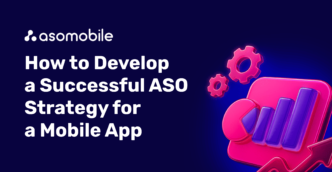Google Play app ranking factors 2024
Google Play ranking factors provide us with a field for optimizing games and applications. It is with them that we will work to increase the visibility of our application in search results or promote it to higher positions. Unfortunately, there is no clear instruction from the store, especially for Google Play, indicating how and how many keywords to use to accurately achieve visibility, but there are recommendations and already known optimization practices.
What does the Play Console say about ranking factors?
The source is always important, and our resource for Google Play is the Play Console for developers. The goal of this guide is to help users find and use apps and games on Google Play easily.
So what is taken into account when ranking?
- User experience
How the user interacts with different apps, the search path, what devices this happens from. All of this is the focus of the app store when ranking.
- App quality
Accessibility to a wide audience, current technologies and the level of quality.
- Understanding apps by the store
Here is something more specific, to understand the app, the store considers its content, and developers provide information such as the title, description, category and graphic resources. At the same time, Google analyzes user reviews and ratings to effectively rank and organize apps.
- App ranking
Google Play aims to show users the most relevant and high-quality apps based on their location and queries.
Factors affecting the organization of apps include:
- Relevance: Apps are selected based on user queries and their location.
- Quality: Apps with strong technical features and a positive user experience.
- Editorial value: Carefully selected recommendations from the Google Play team.
- Advertising: Developers can advertise their apps in certain sections.
- User experience: We strive to provide a positive experience for navigating and discovering apps.
Here is what we can find on the Google Play help about searching and ranking apps.
What do numerous practitioners of app optimization on Google Play tell us? After all, as we know, optimization lays the foundation for organic traffic and allows us to survive in the difficult competitive struggle of this market.
How does the indexing and ranking algorithm work on Google Play?

Like the App Store, the starting point of interaction will be keywords. It is for ranking and indexing apps that the store needs to analyze search queries contained in the metadata.
Keywords, if placed in the metadata correctly, will be evaluated by relevance and act as a ranking factor. Combining this with other factors - the number of downloads, ratings and reviews, retention and conversion rates, and much more.
Actually, ASO directs all its efforts to working with ranking factors. Understanding them and proper analytics allows us to achieve a constant flow of organic traffic for our application, because the Google Play Search source is the most significant source of traffic for most applications.
Google Play ranking factors - primary and secondary
The main ranking factors are exactly what is related to the app metadata, namely:
- Title (30 characters). This is the most important factor for indexing, because the keywords that we place in this field will play a significant role in ranking. That is why any advice on title optimization begins with the words - use the most relevant search queries, do not limit yourself to the brand.
- Short description (80 characters). It also acts as a ranking factor and mentioning relevant keywords here will help the store algorithm during indexing. The field is not that short, so you can combine marketing (appeal to the user) and optimization goals.
- Description (4000 characters). A field that, despite its size, also acts as an indexing factor. Here we are guided by the idea that we should explain to the user as simply and clearly as possible what our app is about, why it is worth installing and what functions and advantages it has. But the keywords in the description should be used as organically as possible, without interfering with the main purpose of this field.
We talked about how to work with metadata on Google Play in more detail in this article. In addition, it is worth mentioning where exactly and how often keywords are used, which is also important for the algorithm. For example, keywords in the full description that are used at the beginning and several times - receive priority. You can read about working with the full description here.
- Developer name. It is displayed just under the app name, even in search results. Therefore, it contacts the user, but is also indexed by the app store algorithms. Therefore, we fill the developer name with keywords, not missing such an opportunity to influence the ranking.
- Package ID or Package name. Each app in the store has its own unique name, which we assign to it upon release. Although this is insignificant, it still acts as a factor for indexing. It is worth thinking about this opportunity and selecting the necessary queries when launching the app, since it will not be possible to change it later.
- Ratings and reviews. What is in our area of attention, but outside our area of influence. This factor should be considered the main one, since user reviews are indexed in Google Play. In addition, the rating is very important for the store, what ratings users give us, what reviews they share. The rating will accompany our app almost everywhere, therefore it will influence potential users and their decision to install it.
That's it for the keyword-based factors. But the list of those that influence ranking goes on. Let's talk about indirect ranking factors on Google Play. Indirect ranking factors are no less significant for algorithms, but are subject to less control on our part. They give the app store a more complete picture of both the product itself and the process of user interaction with it. What are these factors?
- Number of installations. An important signal for the app store, one of the main ones, you could say. Users search, find and install our app. The indicator is directly related to our efforts to optimize keywords and metadata, plus visual optimization that convinces the user to install the app.
- Conversion rate. Directly related to the previous one and also acts as a ranking factor for the store algorithm. The connection between a keyword search, a visit to our app page and an installation is a clear signal for Google Play that the optimization of text metadata was carried out correctly and the relevance for users was met. This means that the display of the app in the search results completely satisfied the user's requests.
- Retention rate in the application. A signal for the store will be the fact that if the user installed but soon deleted our app, then our product is not quite what he is looking for. For Google Play, it will be important what keywords are used to install the app and stay with it.
- App performance. Android Vitals is a system for evaluating the performance of our product by the store, which includes many technical parameters such as crashes, errors, and the time when the application is not responding. It does not concern keywords at all, but it has a strong impact on ranking. If there is a sharp decrease in indexing and loss of positions, we definitely pay attention to this indicator.
- Google Tags. Tags have existed since 2020, this is a predefined word that describes the content and functionality of our application or game for users. The most important thing is to be guided by the same principle of relevance when choosing these words, i.e. They must relate to the functionality of our app.
- App update. Applications that regularly release updates with bug fixes, performance improvements, and new features may receive preference in algorithms.
- App localization. Although it is difficult to call this a factor for the algorithm, it is definitely important for users. We all prefer to use applications in a language we understand. Therefore, localization affects installations and conversion, and therefore ranking.
- The presence of video. While this isn't mandatory, it can have a significant impact on conversion in some categories.
How can we influence Google Play ranking?
1. Developing an ASO strategy
Keyword Optimization. We need to focus on keywords as they are important for our ranking. We can break our strategy down into the following steps:
- Research: Talk to experts and use tools to find keywords.
- Prioritize: Rank keywords based on relevance, popularity, and competition.
- Target: Determine how and where to use keywords in our listing.
- Evaluate: Track keyword performance and how they impact results.
Combining with conversion tactics: We can improve conversion rates by experimenting with visual elements such as the app icon, screenshots, and videos.
2. User Management and Experience
- Communication with users: We must regularly communicate with users and improve their experience, paying attention to localization and seasonal changes.
- Increasing relevance: The more relevant our app is to our audience, the higher the conversion rates and rankings will be. We will strive to receive positive ratings and reviews, while promptly responding to negative ones.
3. Conversion rate optimization
- Attractive listing: We will create an attractive listing with high-quality screenshots and videos demonstrating the functionality. We will highlight the unique benefits of our app.
- A/B Testing: We will use Google Play Experiments to test different elements of our listing.
- Reducing barriers: We will offer trials and participate in the Google Play Points program to increase user engagement.
4. Tracking keyword rankings
- Monitoring: We will regularly monitor our keyword rankings and their impact on our KPIs. Even if we rank high, we will evaluate how popular and important the keyword is.
- Analysis and adjustment: We will conduct keyword analysis and adjust the strategy as needed to ensure that the keywords contribute to our KPIs.
In fact, all our efforts in ASO are directly or indirectly related to ranking factors. If the iteration did not bring the necessary result in search results, we go back to work with the specified points again and again. Increasing visibility will bear fruit, no matter how labor-intensive it may be.
 Українська
Українська  Русский
Русский  Español
Español 






